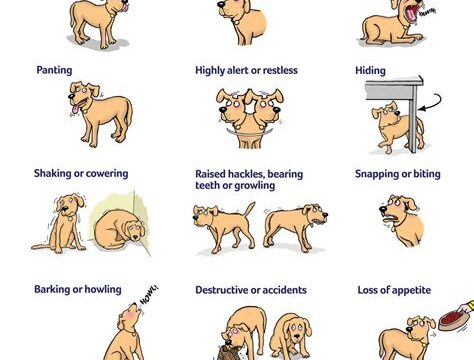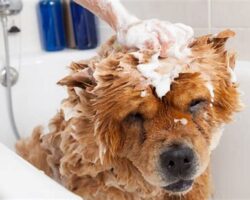Understanding Separation Anxiety in Dogs
Separation anxiety is a common behavioral problem that many dogs experience when they are left alone. It is important for dog owners to understand this issue in order to provide their furry friends with the support and care they need. Separation anxiety can manifest in various ways, such as excessive barking, destructive behavior, urinating or defecating in the house, or even attempting to escape. It is not uncommon for dogs with separation anxiety to become highly distressed when their owners are away, causing stress for both the dog and their owners.
Recognizing the Signs of Separation Anxiety
Recognizing the signs of separation anxiety in dogs is crucial to addressing the issue effectively. Some common signs include excessive panting, drooling, pacing, or whining when the owner prepares to leave or is not present. Dogs with separation anxiety often exhibit destructive behaviors, such as chewing furniture or household items, scratching doors or windows, or trying to dig their way out of rooms. These behaviors are not indicative of disobedience or spite; rather, they are a manifestation of the dog’s distress and anxiety. By being aware of these signs, dog owners can take appropriate steps to help their furry friends cope with their anxiety.
Creating a Safe and Comfortable Environment
Creating a safe and comfortable environment for dogs with separation anxiety is an important step in managing their condition. This can include providing them with a designated safe space, such as a crate or a specific room, where they feel secure. It is also essential to ensure that the environment is free from potential hazards or triggers that may cause further anxiety. Additionally, providing dogs with engaging toys or puzzle feeders can help distract and entertain them during periods of alone time. By creating a positive environment, dog owners can help alleviate their pet’s anxiety and promote a sense of security.
Gradually Introducing Alone Time to Your Dog
Gradually introducing alone time to a dog with separation anxiety is key to helping them build tolerance and reduce their stress levels. Start by leaving the dog alone for short periods, gradually increasing the duration over time. It is important to make these departures and arrivals low-key to avoid heightening the dog’s anxiety. Engaging in pre-departure routines, such as picking up keys or putting on shoes, and then not leaving immediately, can help desensitize the dog to these cues. Providing a comforting item, such as a piece of clothing with the owner’s scent, can also help ease the dog’s anxiety during alone time.
Positive Reinforcement and Counterconditioning Techniques
Positive reinforcement and counterconditioning techniques are effective approaches for addressing separation anxiety in dogs. Rewarding the dog with treats or praise when they display calm and relaxed behavior during alone time can help reinforce positive associations. Gradual desensitization by exposing the dog to short periods of alone time and gradually increasing the duration can also be beneficial. Incorporating activities that the dog enjoys, such as puzzle toys or interactive games, can help redirect their focus and promote positive experiences during alone time. It is important to consult with a professional dog trainer to learn effective techniques for positive reinforcement and counterconditioning.
Seeking Professional Help for Severe Cases
In severe cases of separation anxiety, it may be necessary to seek professional help from a veterinarian or a certified animal behaviorist. These experts can provide guidance and develop a tailored treatment plan for the dog. They may recommend behavior modification techniques, medication to alleviate anxiety, or a combination of both. Professional help can be particularly beneficial if the dog’s separation anxiety significantly impacts their quality of life or if their behaviors pose a risk to themselves or others. Remember, seeking professional assistance is not a sign of failure but rather a proactive step in ensuring the well-being of the dog.
Preventing Separation Anxiety in Puppies
Preventing separation anxiety in puppies is essential for their long-term emotional well-being. Early socialization and exposure to different environments can help puppies build confidence and resilience. Gradually introducing brief periods of alone time, even when the puppy is not showing signs of anxiety, can help them develop a positive association with being alone. Avoiding prolonged periods of isolation and providing appropriate mental and physical stimulation are also crucial. Additionally, enrolling puppies in puppy classes or training programs can help build their skills and reinforce positive behaviors. By taking proactive measures, dog owners can minimize the likelihood of separation anxiety developing in their puppies.
Understanding separation anxiety in dogs is vital for providing them with the care and support they need. By recognizing the signs, creating a safe environment, gradually introducing alone time, and utilizing positive reinforcement techniques, dog owners can help their furry friends overcome their anxiety. In severe cases, seeking professional help is crucial for developing an effective treatment plan. By taking preventative measures with puppies, dog owners can reduce the risk of separation anxiety later in life. Remember, with patience, understanding, and proper care, dogs with separation anxiety can lead happy and fulfilling lives.
Recognizing the Signs of Separation Anxiety
Separtion anxiety in dogs can be a challenging issue for pet owners to manage. It is important to recognize the signs of separation anxiety in order to address it effectively. Dogs with separation anxiety may exhibit several symptoms when they are left alone or when they anticipate being left alone. These signs can range from mild to severe, and understanding them can help pet owners take the necessary steps to help their furry friends cope with this condition.
One of the most common signs of separation anxiety is destructive behavior. Dogs may chew on furniture, clothing, or household items when they are left alone. This behavior is typically focused on items with the owner’s scent, as it provides comfort and reassurance to the anxious dog. Chewing can be a form of stress relief for dogs, but it can also result in costly damage to the home.
Another sign of separation anxiety is excessive barking or howling. Dogs may vocalize their distress by barking or howling incessantly when left alone. This behavior is often accompanied by restlessness and pacing. Some dogs may also engage in self-destructive behavior, such as scratching at doors or windows in an attempt to escape. Excessive barking can be disruptive not only to the household but also to neighbors.
Furthermore, dogs with separation anxiety may display various physical symptoms. These can include panting, salivating excessively, and even losing control of their bladder or bowels. These signs are indicative of extreme stress and anxiety. If a dog consistently exhibits physical symptoms of distress when left alone, it is essential to address the underlying separation anxiety to ensure their well-being.
+————-+————-+
| Key Points | Significance|
+————-+————-+
| Destructive behavior | Indicates stress and can cause damage to the home.|
| Excessive barking | Disruptive to the household and neighbors. |
| Physical symptoms | Indicate extreme stress and anxiety. |
+————-+————-+
Creating a Safe and Comfortable Environment
The environment in which your dog spends time plays a crucial role in their overall well-being and can significantly impact their behavior, including the development of separation anxiety. By creating a safe and comfortable environment for your furry friend, you can help alleviate their stress and promote a sense of security.
1. Provide a designated area: Having a specific area where your dog can retreat to when they feel anxious or overwhelmed can be incredibly beneficial. This can be a cozy corner with their bed, toys, and a few familiar items that make them feel relaxed. Make this area off-limits to other family members or pets to ensure it remains a safe space for your dog.
2. Use calming scents: Certain scents, such as lavender or chamomile, have calming effects on dogs. Consider using essential oil diffusers or sprays in your dog’s designated area to create a soothing atmosphere. However, always make sure to use pet-safe products and consult with your veterinarian before introducing any new scents.
3. Noise control: Loud and sudden noises can trigger anxiety in dogs. Minimize environmental noises as much as possible by closing windows, using soundproof curtains, or playing soft background music to provide a consistent and soothing ambient sound. This can help mask any external noises that may startle your pup.
4. Maintain a routine: Dogs thrive on routine and predictability. Establish a consistent daily schedule for feeding, exercise, and playtime. By doing so, your dog will develop a sense of security and know what to expect, reducing the likelihood of anxiety when they are left alone.
5. Proper crate training: Crates can be a safe haven for dogs if used correctly. Ensure that the crate is comfortable and spacious enough for your dog to stand, turn around, and lie down comfortably. Introduce crate training gradually, using positive reinforcement techniques, and never use the crate as a form of punishment.
Creating a safe and comfortable environment is an essential step in managing separation anxiety in dogs. Remember that each dog is unique, so it may take some trial and error to determine what works best for your furry friend. With patience, consistency, and a loving environment, you can help your dog feel more secure and relaxed when left alone.
Gradually Introducing Alone Time to Your Dog
As a responsible dog owner, it is important to ensure that your furry friend feels comfortable and secure when left alone. Dogs are social animals and can develop separation anxiety if not properly trained to spend time on their own. Gradually introducing alone time to your dog is a crucial step in preventing separation anxiety and promoting their overall well-being.
One effective way to gradually introduce alone time is by starting with short periods and gradually increasing the duration. Begin by leaving your dog alone for just a few minutes, and then gradually extend this time as they become more comfortable. This helps them understand that being alone is not a negative experience and that you will always return.
It is also essential to create a safe and comfortable environment for your dog during their alone time. Provide them with a designated space where they feel secure, such as a cozy crate or a specific room in the house. Make sure this area is equipped with their favorite toys, a comfortable bed, and some familiar scents, such as a piece of your clothing, to help them feel more at ease.
List of tips for gradually introducing alone time:
- Start with short periods of alone time: Begin by leaving your dog alone for just a few minutes and gradually increase the duration over time.
- Create a safe and comfortable environment: Provide your dog with a designated space that includes their favorite toys, a comfortable bed, and familiar scents.
- Use positive reinforcement: Reward your dog with treats or praise when they handle alone time well, reinforcing positive behavior and associating it with being alone.
Using positive reinforcement techniques is another effective way to help your dog adjust to being alone. Whenever they handle alone time well, reward them with treats, praise, or playtime. This positive reinforcement creates a positive association with being alone and encourages them to feel more comfortable and confident in your absence.
If you notice that your dog is struggling to adjust to being alone, do not hesitate to seek professional help. A certified dog trainer or animal behaviorist can provide valuable guidance and support, tailoring a training plan specifically for your dog’s needs. They can identify any underlying issues and help you address them effectively.
| Signs of separation anxiety in dogs: |
|---|
| Pacing and restlessness |
| Excessive barking or howling |
| Destructive behavior |
| Loss of appetite |
| Self-harm or escape attempts |
Remember, preventing separation anxiety is always easier than treating it. By gradually introducing alone time to your dog in a positive and supportive manner, you can help them become well-adjusted and confident when left on their own. Patience, consistency, and love are key ingredients in this process, ensuring a happy and emotionally healthy canine companion for years to come.
Positive Reinforcement and Counterconditioning Techniques
Positive reinforcement and counterconditioning techniques are essential tools for addressing separation anxiety in dogs. These techniques focus on promoting positive associations and reducing fear and anxiety in your furry friend. By using these methods consistently and patiently, you can help your dog learn to feel comfortable and calm when left alone.
Positive reinforcement involves rewarding your dog for desired behaviors, such as staying calm or engaging in activities that promote relaxation. This can be done by offering treats, praise, or playtime whenever your dog displays the desired behavior. By associating positive experiences with being alone, your dog will start to view alone time more positively.
Counterconditioning involves changing your dog’s emotional response to being alone. This technique focuses on exposing your dog to gradually increasing periods of alone time in a controlled and positive way. Start by leaving your dog alone for short periods and gradually increase the duration as your dog becomes more comfortable and relaxed. Pairing this alone time with enjoyable activities, such as food puzzles or interactive toys, can also help create positive associations.
Desensitization is another important aspect of counterconditioning. It involves exposing your dog to the triggers of their separation anxiety, such as picking up your keys or putting on your shoes, without leaving. By repeatedly exposing your dog to these triggers without actually leaving, you can gradually reduce their anxiety response and help them become more accustomed to these cues.
To further enhance the effectiveness of positive reinforcement and counterconditioning techniques, it is important to establish a safe and comfortable environment for your dog. Make sure they have access to their favorite toys, a cozy bed, and a designated space where they feel secure. Implementing a predictable routine and providing mental stimulation through puzzle toys or interactive games can also help alleviate anxiety and keep your dog occupied during alone time.
Remember, consistency and patience are key when implementing these techniques. It may take time for your dog to overcome separation anxiety, but with positive reinforcement, counterconditioning, and a loving environment, you can help them develop the confidence and resilience to handle alone time with ease.
- Consistently reward desired behaviors with treats, praise, or playtime.
- Gradually expose your dog to increasing periods of alone time.
- Pair alone time with enjoyable activities, such as food puzzles.
- Desensitize your dog to triggers by repeatedly exposing them without leaving.
- Create a safe and comfortable environment with favorite toys and a cozy bed.
- Establish a predictable routine and provide mental stimulation.
- Be patient and consistent in your training efforts.
| Positive Reinforcement | Counterconditioning | Desensitization |
|---|---|---|
| Reward desired behaviors with treats, praise, or playtime | Expose your dog to gradually increasing periods of alone time | Repeatedly expose your dog to triggers without leaving |
| Associate positive experiences with being alone | Pair alone time with enjoyable activities | Reduce anxiety response to common departure cues |
Seeking Professional Help for Severe Cases
If your dog is experiencing severe separation anxiety, it is crucial to seek professional help. While mild cases can often be managed with behavioral training and desensitization exercises, severe cases may require the expertise of a dog behaviorist or a certified professional dog trainer. These professionals have extensive knowledge and experience in dealing with separation anxiety in dogs and can provide tailored solutions to address your dog’s specific needs.
When seeking professional help, it is important to consider their qualifications and experience in dealing with separation anxiety. Look for someone who specializes in canine behavior and has a proven track record of successfully treating separation anxiety in dogs. Seek recommendations from trusted sources such as your veterinarian or fellow dog owners who have dealt with similar issues.
A professional will conduct a thorough assessment of your dog’s behavior and environment to determine the underlying causes of their anxiety. They may recommend a multi-faceted approach that includes behavior modification techniques, medication (if necessary), and environmental modifications to create a calming and secure space for your dog. Additionally, they can provide guidance and support throughout the training process, helping you and your dog gradually overcome separation anxiety.
Preventing Separation Anxiety in Puppies
Separation anxiety is a common issue that many puppies experience when they are left alone. It can be distressing for both the puppy and their owner, but the good news is that there are steps you can take to prevent separation anxiety from developing in the first place. By implementing a few key strategies, you can help your puppy feel more secure and confident when they are on their own.
Firstly, it is important to gradually introduce your puppy to being alone. Begin by leaving them alone for short periods of time, gradually increasing the duration as they become more comfortable. This will help them build up their independence and learn that being alone is not something to be feared. Make sure to provide toys and treats to keep them occupied while you’re away.
Another important aspect of preventing separation anxiety is creating a safe and comfortable environment for your puppy. Make sure they have a designated space that is their own, complete with a cozy bed and plenty of toys. This will help them feel secure and provide a sense of familiarity when they are left alone. Additionally, consider leaving a piece of clothing with your scent on it, as this can provide comfort and reassurance to your puppy when you are not around.
Positive reinforcement and counterconditioning techniques can also be incredibly effective in preventing separation anxiety. Whenever you leave your puppy alone and they remain calm, be sure to praise and reward them. This will help them associate being alone with positive experiences. Additionally, consider playing calming music or leaving a soothing pheromone diffuser in the room to create a sense of relaxation and tranquility.
While these strategies can be highly effective, it is important to remember that every puppy is different. If you find that your puppy is showing signs of severe separation anxiety despite your efforts, it may be necessary to seek professional help. A qualified dog trainer or veterinarian can provide guidance and develop a tailored plan to address your puppy’s specific needs.
In conclusion, preventing separation anxiety in puppies is all about gradual exposure, creating a comfortable environment, and using positive reinforcement techniques. By taking these proactive steps, you can help your puppy develop the confidence and independence necessary to thrive when they are alone. Remember to be patient and consistent, and most importantly, show your puppy plenty of love and understanding throughout the process.
Frequently Asked Questions
Q: What are the signs of separation anxiety in dogs?
A: Some signs of separation anxiety in dogs include excessive barking or howling when left alone, destructive behavior, urinating or defecating indoors, pacing, and excessive drooling.
Q: How can I create a safe and comfortable environment for my dog?
A: You can create a safe and comfortable environment for your dog by providing a designated area with their bed or crate, leaving them with toys or puzzle feeders to occupy their time, and playing calming music or leaving a TV on to provide background noise.
Q: How can I gradually introduce alone time to my dog?
A: Gradually introducing alone time to your dog can be done by starting with short periods of separation, gradually increasing the time over days or weeks. You can also use cues like picking up your keys or putting on your coat to help your dog associate these actions with you leaving but eventually not always meaning you’ll be gone for a long time.
Q: What are positive reinforcement and counterconditioning techniques?
A: Positive reinforcement techniques involve rewarding good behavior to encourage it, while counterconditioning involves changing your dog’s emotional response to being alone by associating it with positive experiences or distractions.
Q: When should I seek professional help for separation anxiety in my dog?
A: You should consider seeking professional help if your dog’s separation anxiety is severe and causing a significant disruption to their life and your household. A professional can provide behavior modification techniques and medication if necessary.
Q: How can I prevent separation anxiety in puppies?
A: To prevent separation anxiety in puppies, it’s important to gradually introduce them to alone time from a young age, provide them with plenty of mental and physical stimulation, and avoid making leaving and returning a big deal.
Q: Can separation anxiety be cured in dogs?
A: While separation anxiety cannot always be cured completely, it can be managed and improved with the right tools and techniques. Working with a professional and consistently implementing a training plan can help reduce the symptoms and make your dog more comfortable when left alone.





